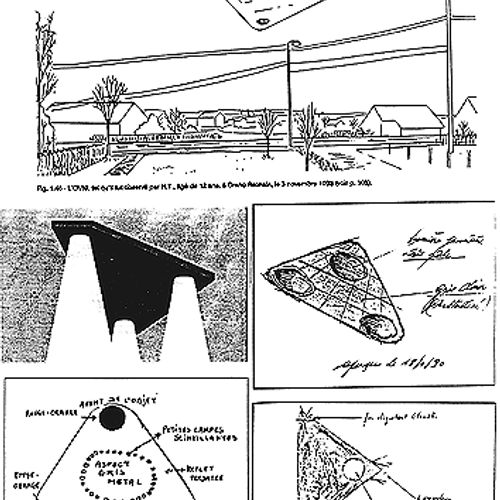| ID | #1612429170 |
| Added | Thu, 04/02/2021 |
| Author | July N. |
| Sources | |
| Phenomena | |
| Status | Hypothesis
|
Initial data
Public interest in the wave peaked with the radar-visual and jet scrambling incident on the night of March 30-31, 1990. This clash was seen and reported by hundreds of citizens.
A preliminary report prepared by Major P. Lambrechts of the Belgian Air Force General Staff was transmitted to SOBEPS.
The "Report on the UFO sightings on the night of March 30 to 31, 1990" includes a detailed chronology of events and refutes several hypotheses, such as optical illusions, balloons, meteorological inversions, military aircraft, holographic projections, etc.
The incident began at 22: 50 on March 30, when the gendarmerie called the radar "chief dispatcher in Glonse" and reported "three unusual lights forming an equilateral triangle". In the next few minutes, the gendarmes confirmed the presence of the lights. When the NATO facility in Semmerzak discovered an unknown target at 23:49, it was decided to take two F-16 fighters into the air.
The planes took off at 0: 05. from the nearest air base, Bovechen, on March 31, and flew just over an hour. According to Major Lambrecht's report:
"The aircraft had short radar contacts several times, [but the pilots] ... We have never made visual contact with a UFO ... every time the pilots managed to capture the capture of one of the targets for a few seconds, this led to a sharp change in the behavior of the detected targets… [During the first capture at 0: 13], their speed changed in minimum time from 150 to 970 knots [170 to 1,100 mph and 275 to 1,800 km / h] and from 9,000 to 5,000 feet [2,700 m to 1,500 m], then returning to 11,000 feet [3,300 m] to move back to ground level."
Electronic Warfare Center (EWC) The Air Force conducted a much more detailed technical analysis of the F-16's computerized radar tapes under the direction of Colonel Salmon and physicist M. Gilmard. Their research was completed in 1992 and was later reviewed by Professor Messen.
Although many aspects of the case still remain unexplained, Messen and SOBEPS mostly accepted the Gilmard-Salmon hypothesis that some of the radar contacts were indeed "angels" caused by a rare meteorological phenomenon.
Original news
The incident began at 22:50 hrs. on March 30 when the Gendarmerie telephoned the radar “master controller at Glons” to report “three unusual lights forming an equilateral triangle.” More gendarmes confirmed the lights in the following minutes. When the NATO facility at Semmerzake detected an unknown target at 23:49 hrs., a decision to scramble two F-16 fighters was made. The jets took off at 0:05 hrs. from Beauvechain, the nearest air base, on March 31 and flew for just over an hour. According to Major Lambrecht’s report:
“The aircraft had brief radar contacts on several occasions, [but the pilots]… at no time established visual contact with the UFOs… each time the pilots were able to secure a lock on one of the targets for a few seconds, there resulted a drastic change in the behavior of the detected targets… [During the first lock-on at 0:13 hrs.] their speed changed in a minimum of time from 150 to 970 knots [170 to 1,100 mph and 275 to 1,800 km./hr.] and from 9,000 to 5,000 feet [2,700 m. to 1,500 m.], returning then to 11,000 feet [3,300 m.] in order to change again to close to ground level.”135
The Electronic War Center (EWC) of the Air Force undertook a much more detailed technical analysis of the F-16 computerized radar tapes, led by Col. Salmon and physicist M. Gilmard. Their study was completed in 1992 and was later reviewed by Professor Meessen.
Although many aspects of this case still remain unexplained, Meessen and SOBEPS have basically accepted the Gilmard-Salmon hypothesis that some of the radar contacts were really “angels” caused by a rare meteorological phenomenon. This became evident in four lock-ons, “where the object descended to the ground with calculations showing negative [emphasis added] altitude… It was evidently impossible that an object could penetrate the ground, but it was possible that the ground could act as a mirror.” Meessen explained how the high velocities measured by the Doppler radar of the F-16 fighters might result from interference effects. He points out, however, that there is another radar trace for which there is no explanation to date. As for the visual sightings of this event by the gendarmes and others, Meessen suggests that they could possibly have been caused by stars seen under conditions of “exceptional atmospheric refraction.”
Hypotheses
False targets on the radar

Marks from unknown unidentified targets appeared on the radar indicator screens. Mysterious reflected signals were also received in a clear atmosphere from areas where there seemed to be nothing…
Investigation
Resume
Similar facts
Log in or register to post comments

